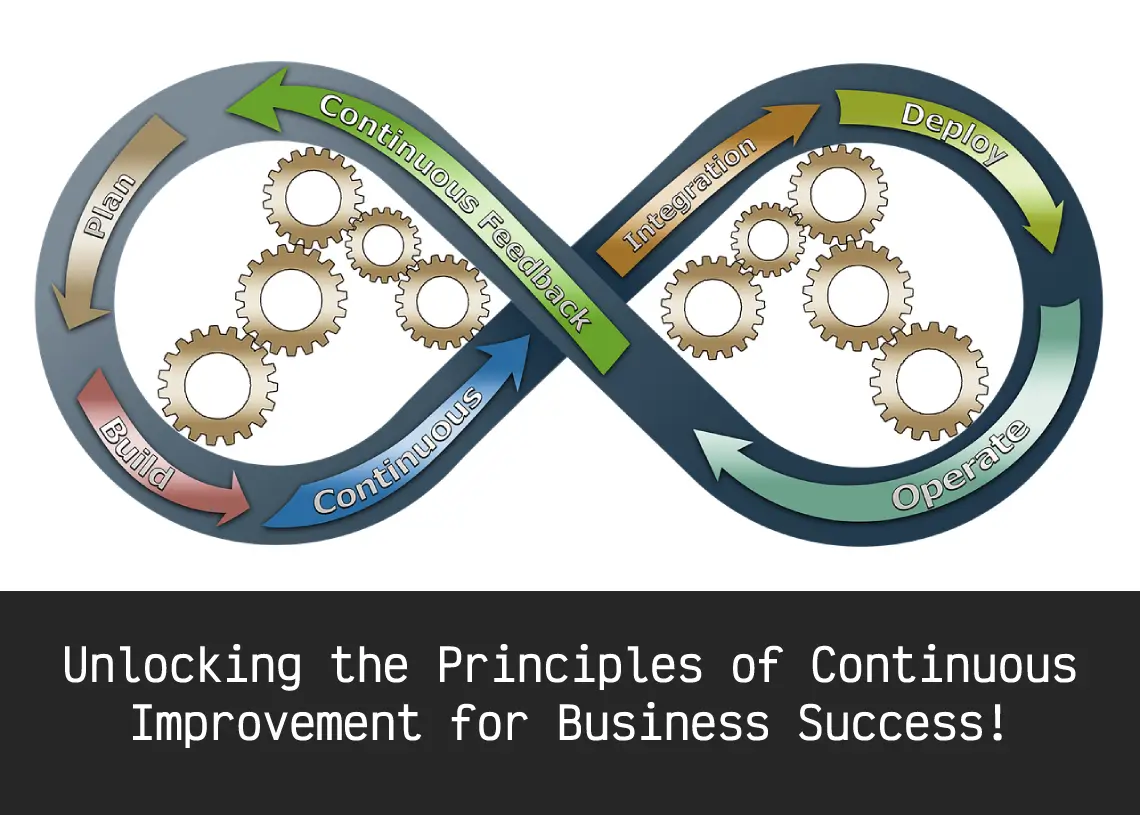Continuous improvement is a method of achieving business success by continually improving processes and performance. It’s a key part of any successful business strategy and can help you stay ahead of the competition. In this blog, we’ll be discussing the principles of the continuous improvement and how you can use them to ensure success for your business.
Introduction to the Principles of Continuous Improvement
The principles of continuous improvement are based on the idea that any process or activity can be improved upon. This means that a business should always be looking for ways to make their processes more efficient, cost-effective, and customer-friendly. The goal of continuous improvement is to create an environment of constant improvement, where employees are encouraged to take initiative and come up with innovative ways to improve the business.
The core principles of the continuous improvement system are:
- Set clear goals: It’s important to have a clear vision of what you want to achieve with your continuous improvement efforts. A goal should be specific, measurable, achievable, and time-bound.
- Analyze data: Collecting data and analyzing it is a key part of continuous improvement. This data can help you identify areas of improvement and make educated decisions about how to achieve your goals.
- Take action: Once you’ve identified areas of improvement, it’s important to take action to implement the changes you want to make. This could include changing processes, introducing new technologies, and training employees.
- Monitor progress: To ensure that you’re making progress towards your goals, it’s important to regularly monitor and measure the results of your efforts. This will help you identify areas where further improvement is needed.
These principles are designed to help businesses create a culture of continuous improvement, which can have a positive impact on all areas of a business.
Benefits of Continuous Improvement
Continuous improvement has a number of benefits for businesses. The most obvious benefit is increased efficiency and cost savings, as businesses can identify opportunities to streamline processes and eliminate waste. Additionally, continuous improvement can lead to increased customer satisfaction and loyalty, as customers are more likely to return to businesses that are constantly striving to improve their products and services.
Other benefits of continuous improvement include:
- Improved quality: Continuous improvement can help businesses identify areas where their products or services can be improved, resulting in higher quality goods and services.
- Increased innovation: By encouraging employees to come up with creative and innovative solutions to problems, businesses can stay ahead of the competition and create unique offerings.
- Improved morale: When employees are given the opportunity to take initiative and come up with new ideas, they feel valued and motivated to work harder. This can lead to increased employee satisfaction and improved morale.
These benefits demonstrate why businesses should strive to create a culture of continuous improvement.
Identifying Areas for Improvement
Identifying areas for improvement is the first step in the continuous improvement process. It’s important to take a comprehensive approach and consider all aspects of the business, from processes and products to customer service and marketing.
Here are some key areas to consider:
- Processes: Are there any processes that could be improved or streamlined? Are there any redundant steps that could be eliminated?
- Products and services: Are there any areas where the quality of products and services could be improved? Are there any new products or services that could be introduced?
- Customer service: Are there any areas where customer service could be improved? Are there any new ways to engage with customers?
- Marketing: Are there any areas where marketing efforts could be improved? Are there any new marketing strategies that could be implemented?
By considering these areas, businesses can identify areas of improvement and make educated decisions about how to achieve their goals.
Creating a Plan for Improvement
Once you’ve identified areas for improvement, it’s time to create a plan for how to achieve them. A good plan should include clear goals and objectives, as well as a timeline for implementation. It’s also important to consider the resources and budget needed to implement the changes.
Some key steps to consider when creating a plan for improvement include:
- Define the goals: Start by defining the goals you want to achieve with your continuous improvement efforts. Make sure these goals are specific, measurable, achievable, and time-bound.
- Identify the resources: Consider the resources and budget needed to implement the changes. This will help you determine how much you need to invest in order to achieve your goals.
- Develop an action plan: Develop an action plan outlining the steps needed to achieve your goals.
- Assign responsibilities: Assign specific tasks and responsibilities to ensure that each step of the plan is executed properly.
By creating a comprehensive plan for improvement, businesses can ensure that their efforts are focused and effective.
Implementing Continuous Improvement Strategies
Once you’ve created a plan for improvement, it’s time to start implementing the changes. This could involve changing processes, introducing new technologies, and training employees. It’s important to ensure that all employees understand the changes and are on board with them.
Some key steps to consider when implementing continuous improvement strategies include:
- Communicate with employees: Make sure that all employees understand the changes and are on board with them. This will help to ensure that the implementation process goes smoothly.
- Train employees: Train employees on the new processes and technologies being introduced. This will help them understand how to use the new systems and apply the changes effectively.
- Monitor progress: Monitor the progress of the implementation process to ensure that the changes are taking effect.
- Make adjustments: Make any necessary adjustments to the plan or processes as needed.
By implementing continuous improvement strategies, businesses can ensure that the changes are taking effect and achieving their desired results.
Measuring Improvement
Once the changes have been implemented, it’s important to measure the results to ensure that the improvements are having the desired effect. This can be done by collecting data and analyzing it to identify any areas where further improvement is needed.
Here are some key metrics to consider when measuring improvement:
- Cost savings: Are there any processes or activities where costs have been reduced?
- Efficiency: Are any processes or activities being completed more quickly or efficiently?
- Customer satisfaction: Are customers more satisfied with the products or services being offered?
- Employee satisfaction: Are employees more motivated and engaged with their work?
By measuring the results of your continuous improvement efforts, you can identify areas where further improvement is needed and make adjustments as needed.
Analyzing and Adjusting Your Improvement Strategies
Once you’ve measured the results of your improvement efforts, it’s important to analyze the data and make any necessary adjustments to your strategies. This could involve making changes to processes, introducing new technologies, or training employees.
Here are some key steps to consider when analyzing and adjusting your improvement strategies:
- Review the data: Review the data collected from your improvement efforts to identify any areas of improvement or areas that need further attention.
- Make adjustments: Make any necessary adjustments to the processes or technologies being used.
- Train employees: Train employees on any new processes or technologies being implemented.
- Monitor progress: Monitor the progress of the implementation process to ensure that the changes are taking effect.
By analyzing and adjusting your improvement strategies, businesses can ensure that their efforts are effective and achieving their desired results.
Reevaluating Your Improvement Goals
It’s important to regularly reevaluate your improvement goals to ensure that they are still relevant and achievable. This could involve setting new goals or adjusting existing ones.
Here are some key steps to consider when reevaluating your improvement goals:
- Evaluate progress: Evaluate the progress of your improvement efforts to determine if the goals are still achievable.
- Set new goals: Set new goals if necessary. Make sure these goals are specific, measurable, achievable, and time-bound.
- Monitor progress: Monitor the progress of the implementation process to ensure that the changes are taking effect.
- Make adjustments: Make any necessary adjustments to the processes or technologies being used.
By reevaluating your improvement goals regularly, businesses can ensure that their efforts are focused and effective.
Integrating Continuous Improvement with Your Overall Business Plan
Continuous improvement should be integrated into your overall business plan. This means that all areas of the business should be considered when creating improvement goals and strategies.
Some key steps to consider when integrating continuous improvement with your overall business plan include:
- Define the goals: Start by defining the goals you want to achieve with your continuous improvement efforts. Make sure these goals are specific, measurable, achievable, and time-bound.
- Identify areas of improvement: Identify areas of improvement in all aspects of the business, from processes and products to customer service and marketing.
- Develop an action plan: Develop an action plan outlining the steps needed to achieve your goals.
- Monitor progress: Monitor the progress of the implementation process to ensure that the changes are taking effect.
By integrating continuous improvement into your overall business plan, businesses can ensure that their efforts are comprehensive and effective.
Conclusion
Continuous improvement is a key part of any successful business strategy. It can help businesses improve their processes, increase efficiency, and stay ahead of the competition. In this blog, we discussed the principles of the continuous improvement and how businesses can use them to ensure success.
We discussed the benefits of continuous improvement, how to identify areas for improvement, how to create a plan for improvement, how to implement continuous improvement strategies, and how to measure improvement. We also talked about the importance of reevaluating your improvement goals and integrating continuous improvement into your overall business plan.
By following the principles of the continuous improvement, businesses can create a culture of improvement and ensure success for their business.




